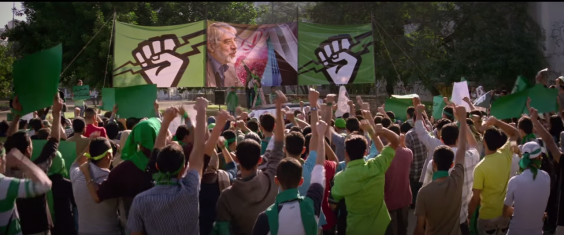Another Shallow Movie
by Yaghoub Yadali translated by Parvaneh Torkamani / April 20, 2015 / No comments

A problematic scene from Desert Dancer. Photo via Youtube user: MOVIECLIPS Trailers.
Desert Dancer’s simplistic portrayal of Iran is damaging to the film’s authenticity.
In principle, a film trailer should include the best and most influential scenes from the feature-length movie so that in a short period of time, about two to three minutes, it can depict a stimulating and enthusiasm-raising summary that presents audiences with a sample of all that they will see in the movie and encourage them to see it. Recently, a friend sent me a trailer for the movie Desert Dancer, a British-made movie set in Iran, and asked me my opinion. Desert Dancer premiered in the US on April 10.

- “Enemy…terrorism…nuclear bomb…war.” These words are often used by American media to describe Iran. The image the media presents is often hazy, incomplete, and distorted. The political and military aspects of my country are covered mainly in a negative light.
- In Under Eastern Eyes (I have adopted the name from the novel Under Western Eyes by Joseph Conrad), I will write about those topics which American media either cannot or does not want to talk about. The emphasis will be on social and cultural aspects of Iran although, out of necessity, I will talk about politics, despite my despair.

- Yaghoub Yadali, born in 1970, is a writer and television director. His first work of fiction, the short-story collection Sketches in the Garden, was published in 1997. It was followed in 2001 by Probability of Merriment and Mooning, which was named book of the year by the Writers and Critics Award. His first novel, The Rituals of Restlessness, won the 2004 Golshiri Foundation Award for the best novel of the year and was named as one of the ten best novels of the decade by the Press Critics Award. He has also published many articles and reviews of literature and cinema in newspapers and magazines in Iran.
To tell the truth, the two minute and thirty second-long trailer shocked me. It was full of obvious and sad mistakes. While the film is supposed to take place in Iran, the atmosphere, mood and customs pictured had no similarity to my country! Some mistakes were so sloppy and obvious and strange that I thought that maybe the director, producers, and/or costume and set designers had not been able to find Iranian consultants for the production of the film. For example, in a scene showing a Green Movement demonstration from 2009, a few hundred people hold big posters with three incorrect letters, rendering the message written on the banners meaningless! The poster ought to show one of the Green Movement’s most important slogans. From another perspective, this whole scene opposes reality. In 2009, there were no small groups of people moving through the streets, carrying posters. Green Movement demonstrations were sporadic and there were never posters involved, except once in a huge demonstration that involved a million people, not a few hundred.
In another scene, during a Green Movement meeting, the viewer sees two posters designed with fists holding an obscure object. There were no such designs in the Green Movement, and there were no such meetings. The director or set designers could have easily found hundreds of minutes of actual Green Movement meetings and demonstrations on YouTube, so as to avoid such ridiculous mistakes.
The worst part of the set design is that the decorations and streets have no similarity to Iran’s actual architecture and housing. The film was made outside Iran, but if you are going to film outside the country, shouldn’t you choose somewhere similar or build scenes similar to the country you want to represent? That would require a lot of attention, and a movie made with a six million dollar budget will not be able to do that. Under those conditions, filmmakers have no choice but to create a caricature similar to what I saw in the trailer.
This simplistic and shallow effort was reflected in the film’s casting, as well. I did not feel as though I was looking at Iranian people. The actors in the film do look Middle Eastern, but the Iranians I have seen all throughout my life do not look like these actors!
The ridiculous mistakes are not insignificant: the security forces’ black uniforms are inaccurate; numbers written on the blackboard in an Iranian elementary school math class are both Persian and English numbers. (Numbers taught in Iranian schools are written only in Persian; a teacher would never use both the Persian and the English numerical system in a math lesson.)
I think these few examples are enough. The question is: how much can viewers trust the contents of a movie that has committed such sloppy, ridiculous, and obvious technical mistakes? Has the director, as the person responsible for all aspects of the film, treated the story the same way he treated the set design and locations? For a cinema expert such as myself, the answer to this question is obvious: I told my friend I would never pay a cent for a movie like Desert Dancer.




